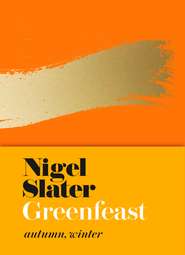
Полная версия:
Greenfeast


Copyright
4th Estate
An imprint of HarperCollinsPublishers 1 London Bridge Street London SE1 9GF www.4thEstate.co.uk
First published in Great Britain by 4th Estate in 2019
Text copyright © Nigel Slater 2019
All recipe photographs © Jonathan Lovekin 2019
Except p. 183 and p. 279 © Nigel Slater 2019
Brushstrokes copyright © Tom Kemp 2019
Nigel Slater asserts the moral right to be identified as the author of this work.
Design by David Pearson
Author photograph by Jenny Zarins
A catalogue record for this book is available from the British Library.
All rights reserved under International and Pan-American Copyright Conventions. By payment of the required fees, you have been granted the non-exclusive, non-transferable right to access and read the text of this e-book on-screen. No part of this text may be reproduced, transmitted, down-loaded, decompiled, reverse engineered, or stored in or introduced into any information storage and retrieval system, in any form or by any means, whether electronic or mechanical, now known or hereinafter invented, without the express written permission of HarperCollins.
Source ISBN: 9780008213770
Ebook Edition © August 2019 ISBN: 9780008218171
Version: 2019-08-21
For James

Tom Kemp
Tom Kemp has had a couple of careers. He trained formally as a theoretical computer scientist and followed a sequence of post-doctoral research and programming posts. In parallel, he was learning to be an artist by studying the writings of ancient manuscripts, not their content but how they were made. In particular, he worked out the details of a Roman signwriting technique which has informed all his brushwork, both readable and abstract. This calligraphic training led to a deeper pursuit of writing in general and artworks in many media, including graffiti and digital work. Along the way he learned to make porcelain vessels on a potter’s wheel, an activity he describes as ‘calligraphy in 3D’, and these now form the large surfaces on which he continues to write.
tomkemp.com
Instagram @tom_kemp_
Contents
Cover
Title Page
Copyright
Dedication
Tom Kemp
Introduction
Winter Basics
A BROWN VEGETABLE STOCK
OATS, DRIED MULBERRIES, DATE SYRUP
In a Pan
ARTICHOKES, BEANS, GREEN OLIVES
AUBERGINES, GINGER, TAMARIND
BRUSSELS SPROUTS, BROWN RICE, MISO
BURRATA, BEANS, TOMATOES
BUTTERNUT, BREADCRUMBS, CURRY POWDER
BUTTERNUT, FETA, EGGS
EGGS, EDAMAME, BEAN SPROUTS
FENNEL, PEAS, HALLOUMI
JERUSALEM ARTICHOKES, PISTACHIOS, GRAPES
MUSHROOMS, HUMMUS, HERBS
PARSLEY, PARMESAN, EGGS
PUMPKIN, ONIONS, ROSEMARY
RAINBOW CHARD, EGG, NOODLES
TOFU, RADISH, PONZU
On Toast
BEETROOT, APPLE, GOAT’S CURD
CRUMPETS, CREAM CHEESE, SPINACH
EGGS, SPINACH, BREAD
LEEKS, CAERPHILLY, MUSTARD
MUSHROOMS, BLUE CHEESE, TOASTING MUFFINS
NAAN, MOZZARELLA, TOMATOES
In the Oven
ARTICHOKES, WINTER ROOTS, SMOKED SALT
BRUSSELS SPROUTS, SMOKED MOZZARELLA, DILL
BUTTER BEANS, PEPPERS, AUBERGINES
CABBAGE, BERBERE SPICE, CRUMBS
CARROTS, SPICES, PANEER
CAULIFLOWER, ONIONS, BAY
CHEDDAR, TARRAGON, EGGS
CHEESE, THYME, GRAPES
CHICKPEAS, RADICCHIO, BUTTER BEANS
FENNEL, CREAM, PINE KERNELS
LENTILS, SWEET POTATO, TOMATOES
MUSHROOMS, CHICKPEAS, TAHINI
ONIONS, TALEGGIO, CREAM
PARSNIPS, SHALLOTS, GOAT’S CURD
PARSNIPS, SMOKED GARLIC, FETA
POTATOES, BRUSSELS SPROUTS
POTATOES, SWEET POTATOES, CREAM
POTATOES, TAHINI, THYME
POTATOES, TOMATOES, HORSERADISH
PUMPKIN, CHICKPEAS, ROSEMARY
PUMPKIN, COUSCOUS, DATE SYRUP
PUMPKIN, MUSTARD, CREAM
SWEET POTATO, JALAPEÑOS, BEANS
SWEET POTATOES, TOMATOES
On a Plate
APPLES, BLUE CHEESE, WALNUTS
BEETROOT, BLOOD ORANGE, WATERCRESS
MUSHROOMS, ORANGE, BREADCRUMBS
RED CABBAGE, CARROTS, SMOKED ALMONDS
With a Crust
FILO PASTRY, CHEESE, GREENS
LEEKS, PARSNIPS, PASTRY
LEEKS, TOMATO, PECORINO
SHALLOTS, APPLES, PARMESAN
SWEDE, MUSHROOM, GRUYÈRE, THYME
SWEET POTATO, PUFF PASTRY
With a Ladle
BEETROOT, LENTILS, GARAM MASALA
BEETROOT, SAUERKRAUT, DILL
BLACK-EYED BEANS, ROSEMARY, KALE
BRUSSELS TOPS, BLUE CHEESE
CELERIAC, HORSERADISH, PUMPERNICKEL
CHEDDAR, CIDER, MUSTARD
FENNEL, CUCUMBER, MINT
MUSHROOMS, BUTTERNUT, SOURED CREAM
NOODLES, LENTILS, SOURED CREAM
ORZO, SMOKED MOZZARELLA, THYME
TAHINI, SESAME, BUTTERNUT
On the Hob
AUBERGINE, TOMATO, COCONUT MILK
CARROTS, RICE, CORIANDER
FREGOLA, GREENS, PECORINO
GNOCCHI, PEAS, EGG YOLK
HARICOT BEANS, RICE, ONIONS
LENTILS, SWEDE, PAPRIKA
MILK, MUSHROOMS, RICE
MOGRABIA, TOMATOES, LABNEH
MUSHROOMS, SPINACH, RICE
ORECCHIETTE, CAULIFLOWER, CHEESE
PARSNIPS, CASHEWS, SPICES
PEARL BARLEY, KALE, GOAT’S CHEESE
POLENTA, GARLIC, MUSHROOMS
POLENTA, THYME, TALEGGIO
RICE, BROCCOLI, PAK CHOI
RICE, LEMON, LIME
SWEET POTATO, COCONUT MILK, CASHEWS
TAGLIATELLE, DILL, MUSHROOMS
TOMATO, CHILLIES, UDON
Pudding
APPLES, CINNAMON, PUFF PASTRY
APPLES, GINGER CAKE, CUSTARD
APPLES, OATS, CHOCOLATE
APPLES, PEARS, RYE
BANANAS, BUTTER, PUFF PASTRY
CHOCOLATE, DRIED FRUIT, PISTACHIOS
CHOCOLATE, DULCE DE LECHE, CANTUCCI
CHOCOLATE, ORANGE ZEST, CANDIED PEEL
DAMSON, ALMOND, SUNFLOWER SEEDS
GINGER CAKE, CARDAMOM, MAPLE SYRUP
HAZELNUTS, BLOOD ORANGES, RICOTTA
ICE CREAM, CHOCOLATE, SHERRY
CRANBERRY, MINCEMEAT, MERINGUE
PAPAYA, PASSION FRUIT, MINT
PEARS, RED WINE, PECORINO
PUDDING RICE, ROSEWATER, APRICOTS
SHERRY, BLOOD ORANGES, CREAM
RICE, MILK, FIG JAM
Index
Acknowledgements
A note on the brushstrokes
A note on the type
About the Author
Also by Nigel Slater
About the Publisher
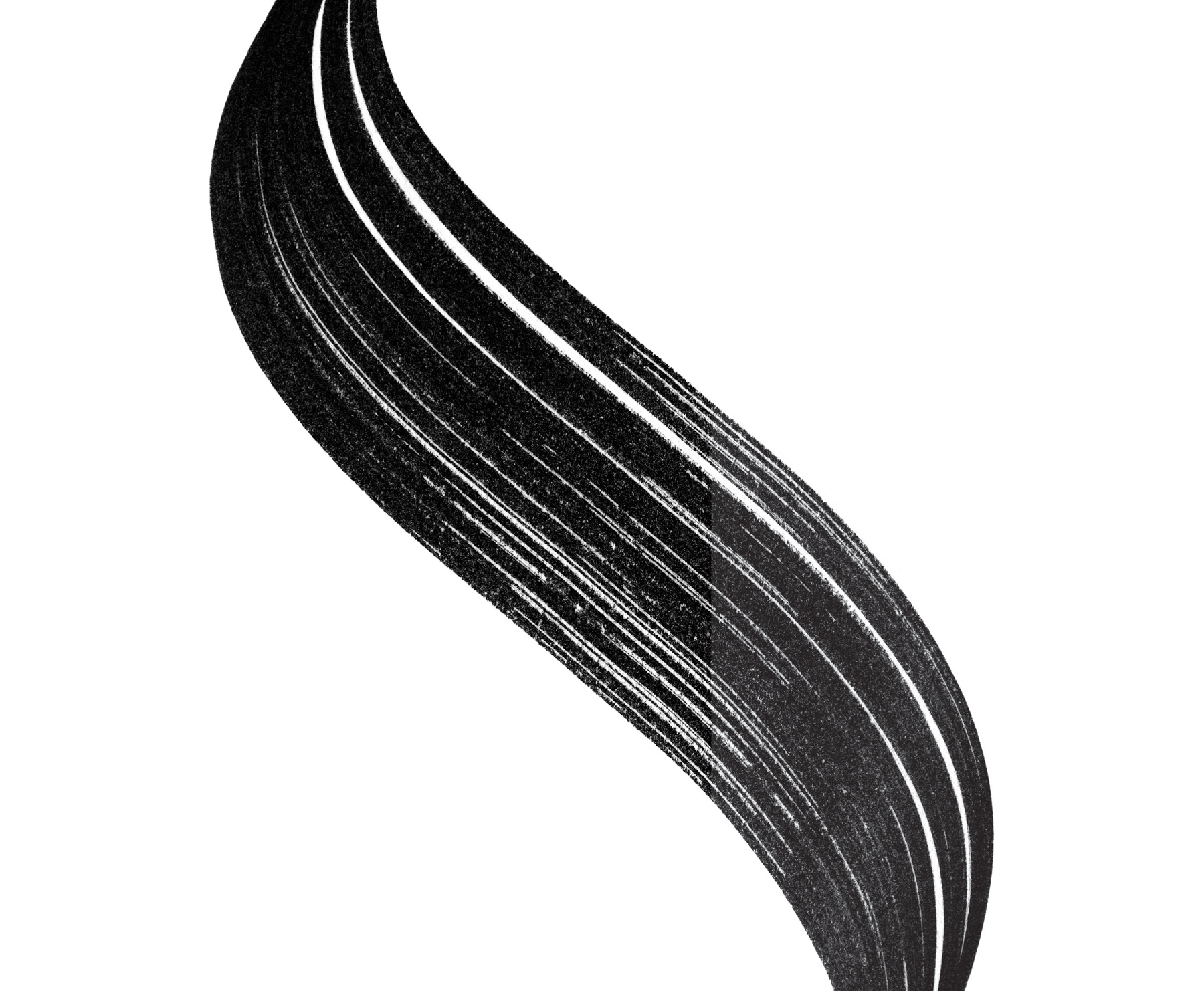
INTRODUCTION
Dinner is different in winter. The change starts late on a summer’s evening, when you first notice the soft, familiar scent of distant woodsmoke in the sudden chill of the evening air. Then, a day or two later, a damp, mushroomy mist hovers over the gardens and parks. Later, you notice the leaves have turned silently from yellow ochre to walnut. Autumn is here once again. You may sigh, rejoice or open a bottle. For many, this is the end of their year. For me, this is when it starts, when warmth, and bonhomie come to the fore. Energy returns.
With the change of weather, supper takes on a more significant role. We are suddenly hungry. Once the nights draw in, I am no longer satisfied by plates of milky burrata and slices of sweet, apricot-fleshed melon. No more am I content with a bowl of couscous with peaches, soft cheese and herbs for dinner. What I crave now is food that is both cosseting and warming, substantial and deeply satisfying. Food that nourishes but also sets me up for going back out in the cold and wet. And yet, I still find my diet is heavily plant-based with less emphasis on meat. It is simply the way it has progressed over the years and shows little sign of abating.
At the start of the longest half of the year, our appetite is pricked by the sudden drop in temperature, and as evenings get longer, we have the opportunity to spend a little more time in the kitchen. To mash beans into buttery clouds. Simmer vegetable stews to serve with bowls of couscous. To bring dishes of sweet potato to melting tenderness in spiced cream. And of course, the pasta jar comes out again.
My cold weather eating is more substantial than the food I eat for the rest of the year. Dinner becomes about one main dish rather than several lighter ones, and the focus shifts towards keeping warm. On returning home I will now happily spend an hour cooking. Maybe a little longer.
The oven gets more use at this time of year, the grill and griddle probably less. More food will come to the table in deep casseroles and pie dishes. I dig out my capacious ladle for a creamed celeriac soup as soft as velvet. The temperature of the plates and bowls will change. We want to hold things that warm our hands, a sign of the happiness to come.
There will be carbs. They protect and energise us. They bring balm to our jagged nerves. (Winter is nature’s way of making us eat carbohydrates.) Crusts – of pastry, breadcrumbs and crumble – add substance; potatoes fill and satisfy and there is once again a huge sourdough loaf on the table. Rice and noodles are no longer a side dish, and now become the heart and soul of dinner.
My autumn and winter cooking is every bit as plant-based as the food I make in the summer; it just has a bit more heft to it. Shallow bowls of rice cooked with milk and thyme in the style of a risotto. A verdant, filling soup of Brussels sprouts and blue cheese. A saffron-coloured stew of sour cream, herbs and noodles. Translucent fritters in a pool of melted cheese. Golden mushrooms astride a cloud of soft, yellow polenta. There is a tangle of noodles and tomato, peppery with chilli; roast parsnips and baked pumpkin; a wide earthenware dish of sweet potatoes and lentils glowing like a lantern, a herb-freckled crumble of leeks and tomato or swedes and thyme in a pastry crust and a tarte Tatin of soft golden shallots and autumn apples. It is all here, between these pumpkin-coloured covers.
This is also the season for ‘something on toast’. By toast I mean not only bread cut thick and rough-edged, but toasted bagels and crumpets, muffins and naan. Any soft dough that will crisp under the grill and will support a cargo of vegetables or is happy to be slathered with a thick wave of crème fraîche or hummus, roast vegetables or perhaps cheese to melt and bubble.
And, of course, there must be pudding. An early autumn crumble of damsons and almonds. Chocolate puddings (you really must make the ones with dulce de leche). Ginger cake with a cardamom cream and a custard pudding set with cake and apples. There will be nut-encrusted shortbreads with blood orange and baked apples with crisp crumbs and cranberries. I expect syllabubs and baked pears on the table, pastries laden with a golden dice of apples and scones pebble-dashed with nibs of dark chocolate.
I probably eat more puddings during the cold months, but mainly at the weekend. The main course recipes in this book are predominantly for two; the puddings, though, are all for four or more. You can’t really make a tart for two or a tiny batch of scones. The recipes are made for sharing with friends and family. That said, most of them are rather fine eaten the following day. Especially those little chocolate puddings.
A note on volume 1. Greenfeast: spring, summer.
Like all my books, the first volume of Greenfeast was written from and about my own kitchen. That it found itself welcomed by quite so many came as something of a pleasant surprise. I have lost count of the number of people who in the last few months have told me that this is the way they eat now, as an ‘almost vegetarian.’
The idea that so many people’s everyday eating is going through such a change and that meat is no longer our first thought when working out what we want to eat, is heartening to say the least. Apparently I am not the only person for whom meat is still looked forward to but as a once- or twice-a-week treat, not the knee-jerk star of every meal. I knew this was happening (you would have to live under a stone not to) but I genuinely hadn’t realised how widely and quickly the change has come about.
Yes, vegan cooking and full-blown vegetarianism is on the rise, but there are far more people who seem to prefer a less rigid approach to their eating. This makes sense on so many levels, but when all is said and eaten it is simply that the options for cooking without meat have never been more varied or delicious. There has never been a better time to celebrate the move towards a mostly plant-based diet.

WINTER STOCK
A good vegetable stock is worth its weight in gold on a winter’s day. As the nights draw in, we probably need a stock altogether deeper, richer and more ballsy than the delicate, vegetal liquids we might use in summer. Something that behaves more like a brown meat stock. Such a broth is immensely useful in my kitchen as a base for the heartier non-meat recipes that form the backbone of my daily eating, but also as something restoring to drink as you might a cup of miso. The colour must be dark and glossy, the flavour deeply, mysteriously herbal with a hint of mushroom and there should be a roasted back note, the sort you find in a long-simmered meat stock.
As you proceed, the kitchen will fill with the smell of onions, celery and carrots, which you roast with miso paste, then remove from the oven and simmer for a good hour with thyme, bay and shiitake. You could slip in a sheet of kombu for an extra layer of depth if you like.
The broth will need straining and separating from its spent aromatics, its deep, almost mahogany liquor dripping slowly into a glass bowl. The liquor can be used immediately, or kept in the fridge, covered, for up to a week.
Such a stock is a bowl of pure treasure. You can drink it like broth, dipping thick hunks of bread or focaccia into it; you can use it as base for a soup, adding steamed cauliflower or shredded cabbage, parsley and croutons, or add noodles, skeins of udon or little pasta stars to twinkle in the dark, mushroomy depths. Whenever the word ‘stock’ appears in a recipe, use it neat or let it down with a little water to taste. And it will freeze too, though I suggest in small containers, so it defrosts quickly.
And when all is said and done, is there anything quite so restoring as coming home to a bowl of deeply layered, smoky stock, to bubble on the stove, to which you add pieces of hot toast, letting them slowly swell with the bosky, fungal, roasted flavours from the bowl.
WINTER PORRIDGE
A winter’s day should start well. A steaming bowl of something to see us on our way. I invariably choose porridge. An oat-based slop to satisfy and strengthen, to bolster and soothe, to see me through till I get where I’m going. A sort of internal duffel coat. I doubt it will just be porridge of course, but porridge with bells and whistles: a trickle of treacle, a pool of crème fraîche, ribbons of maple syrup or a puddle of yoghurt. There may be golden sultanas and dried mulberries, pistachios or toasted almonds and perhaps some baked figs or slices of banana.
Porridge doesn’t necessary mean oats. You could use rye grain or barley and milk or water as you wish. There might be salt or sugar, cinnamon or ground cardamom or toasted pumpkin seeds. If I remember, there will be stewed fruit too: apples perhaps, or dried apricots cooked with sugar or honey. Porridge is never just porridge in my house. It is a winter staple, one of the building blocks of the season and something I could never think of being without.
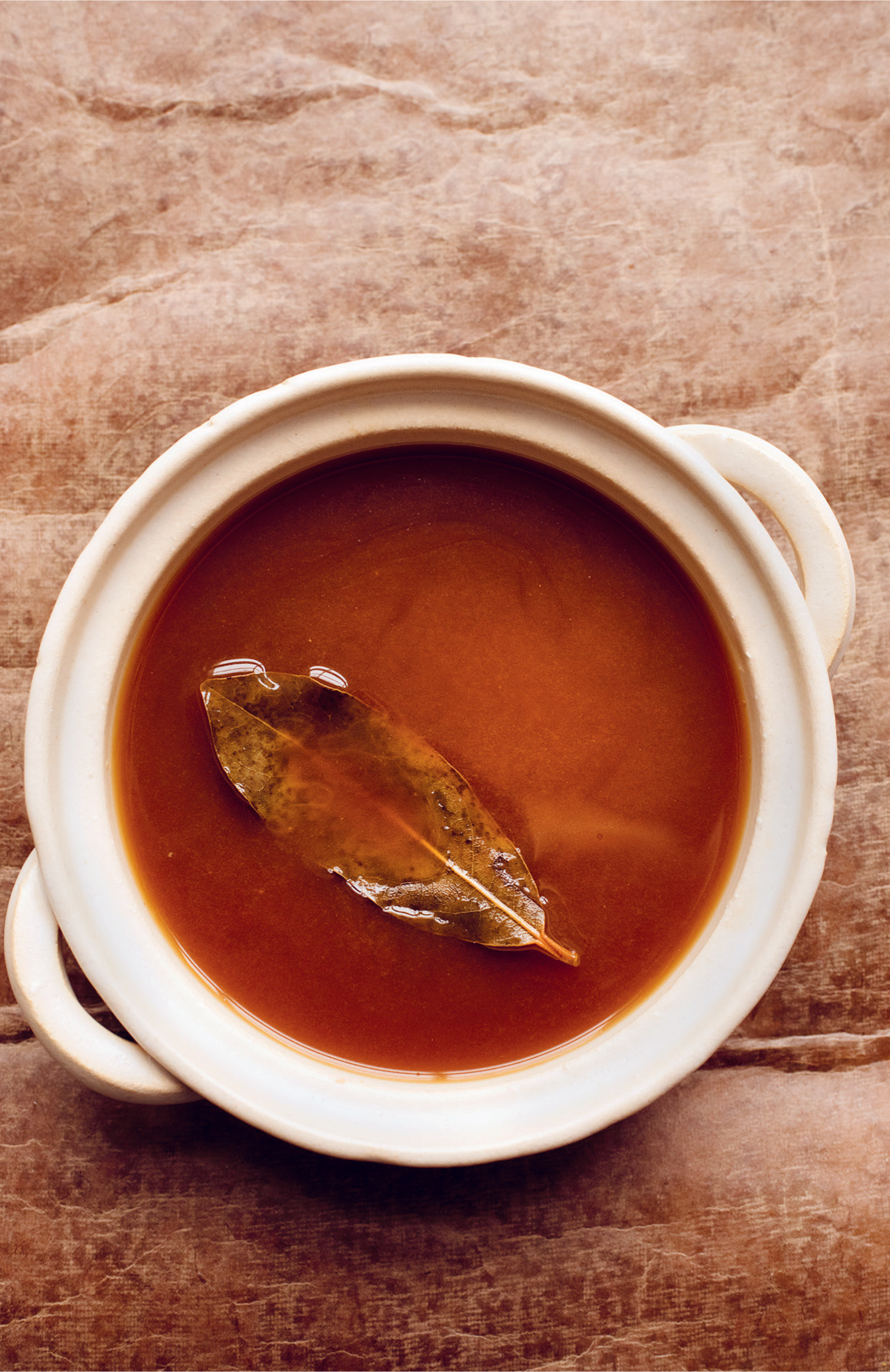
A BROWN VEGETABLE STOCK
Deep flavours. A herbal, umami-rich stock for winter cooking.
Makes about 2 litres
onions, medium 2
carrots 250g
celery 2 sticks
garlic a small, whole head
light miso paste 3 tablespoons
water 80ml, plus 3 litres
dried shiitake mushrooms 50g
rosemary 5 sprigs
thyme 10 sprigs
bay leaves 3
black peppercorns 12
dried kombu 10g
Set the oven at 180°C/Gas 4. Peel and roughly chop the onions, then place in a roasting tin together with the skins. Similarly chop the carrots and celery sticks, then mix with the onions and the head of garlic, separated into cloves.
Mix together the miso paste and 80ml of water, then stir into the vegetables, coating them lightly. Bake for about an hour, tossing the vegetables once or twice during cooking, until everything is brown, fragrant and toasty.
Transfer the roasted vegetables and aromatics to a deep saucepan, add the shiitake, rosemary, thyme, bay, peppercorns and the sheets of kombu, then pour a little of the reserved water into the roasting tin, scrape at the sticky, caramelised bits stuck to the tin, then pour into the saucepan. Add the remaining water. Bring to the boil, then lower the heat and leave to simmer, partially covered with a lid, for fifty minutes to an hour.
When you have a deep brown, richly coloured broth, tip through a sieve into a heatproof bowl or large jug and leave to cool. Refrigerate and use as necessary.
• Keeps for up to one week in the fridge.
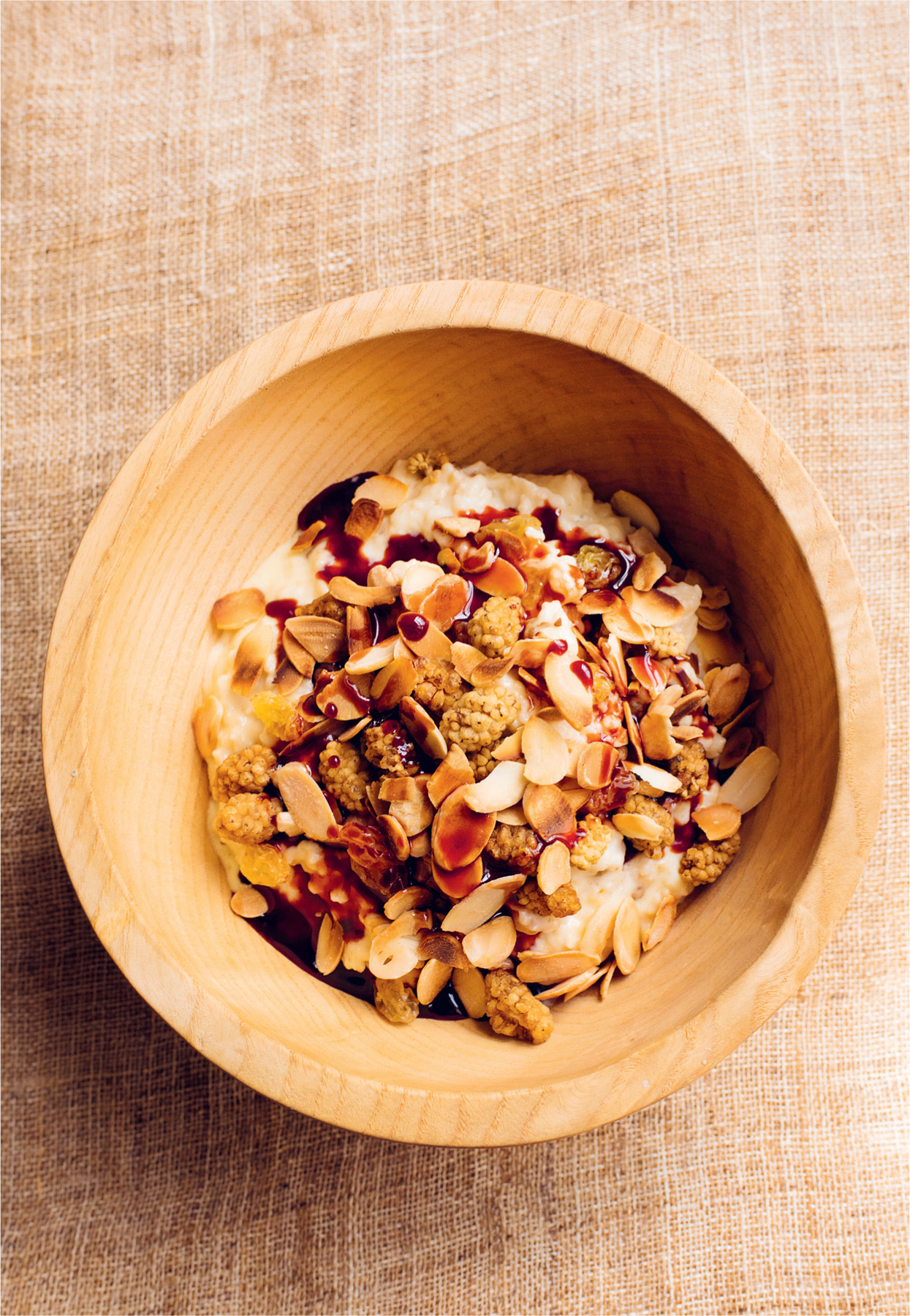
OATS, DRIED MULBERRIES, DATE SYRUP
The solace of porridge. The sweetness of dried fruits.
Serves 2
porridge oats 100g
dried mulberries 50g
golden sultanas 75g
cream or crème fraîche 4 tablespoons
date syrup 2 tablespoons
Put the oats and 400ml of water into a small saucepan and bring them to the boil. Add a good pinch of salt and stir the oats continuously for four or five minutes with a wooden spoon until the porridge is thick and creamy.
Divide between two bowls, then add the dried mulberries and golden sultanas. Add spoonfuls of crème fraîche, then trickle over the date syrup.
• I often use dried apricots in place of the mulberries, but cranberries and dried cherries are good alternatives.
• The sweetness of the date syrup can be balanced by a spoon or two of stewed tart apples.

On a winter’s evening, I warm butter and olive oil in a shallow-sided, cast-iron pan, turn the heat down low and use it to fry thin slices of potato, Jerusalem artichoke or fennel. Vegetables that will crisp or soften as you wish, and to which I can add other ingredients at will – sweet black grapes and whole parsley leaves to the crisp artichokes; peas and salty cheese to the softened fennel. I do the same with slices of pumpkin or butternut squash, then introduce feta or breadcrumbs or perhaps a fried egg whose yolk will double as an impromptu sauce.
A heavy frying pan in which you can leave things to cook at a moderate temperature is worth its weight in gold. It is the gift I would give to a kid leaving home. The possibilities are endless. Mushrooms, sliced and sautéed with herbs to pile on a mound of silken hummus; beans whose outsides slowly crisp in olive oil and are then tossed with tomatoes and a wobbly egg of burrata; Brussels sprouts fried with miso paste to a deep walnut brown, then forked through sticky brown rice. They all give a substantial green and deeply savoury supper. The list is endless.
The success often lies in the pan itself. A pitted or wobbly-based pan will produce uneven results. Sometimes you need a thin-bottomed pan in which to flash-fry, other times a pan as heavy as possible that will hold the heat and which can be left to do its task while you get on with other elements of dinner. Choose your weapon.
It is worth finding a suitable lid. Especially if you are cooking vegetables that need to be brought gently to tenderness before a final crisping, such as potatoes, parsnips and carrots. The sort of heavyweight pans I find so useful for slow winter cooking often come without a lid, so it is not a bad idea to find one that fits before you leave the shop.
I am very fond of my old iron sauté pans, but they do need a bit of care when you first get them home. A good oiling with linseed oil, a long, slow bake in the oven and a careful dry before putting them away will give them a chance to develop a patina, a naturally non-stick layer that will, unlike a commercial non-stick finish, see you through a lifetime of suppers.
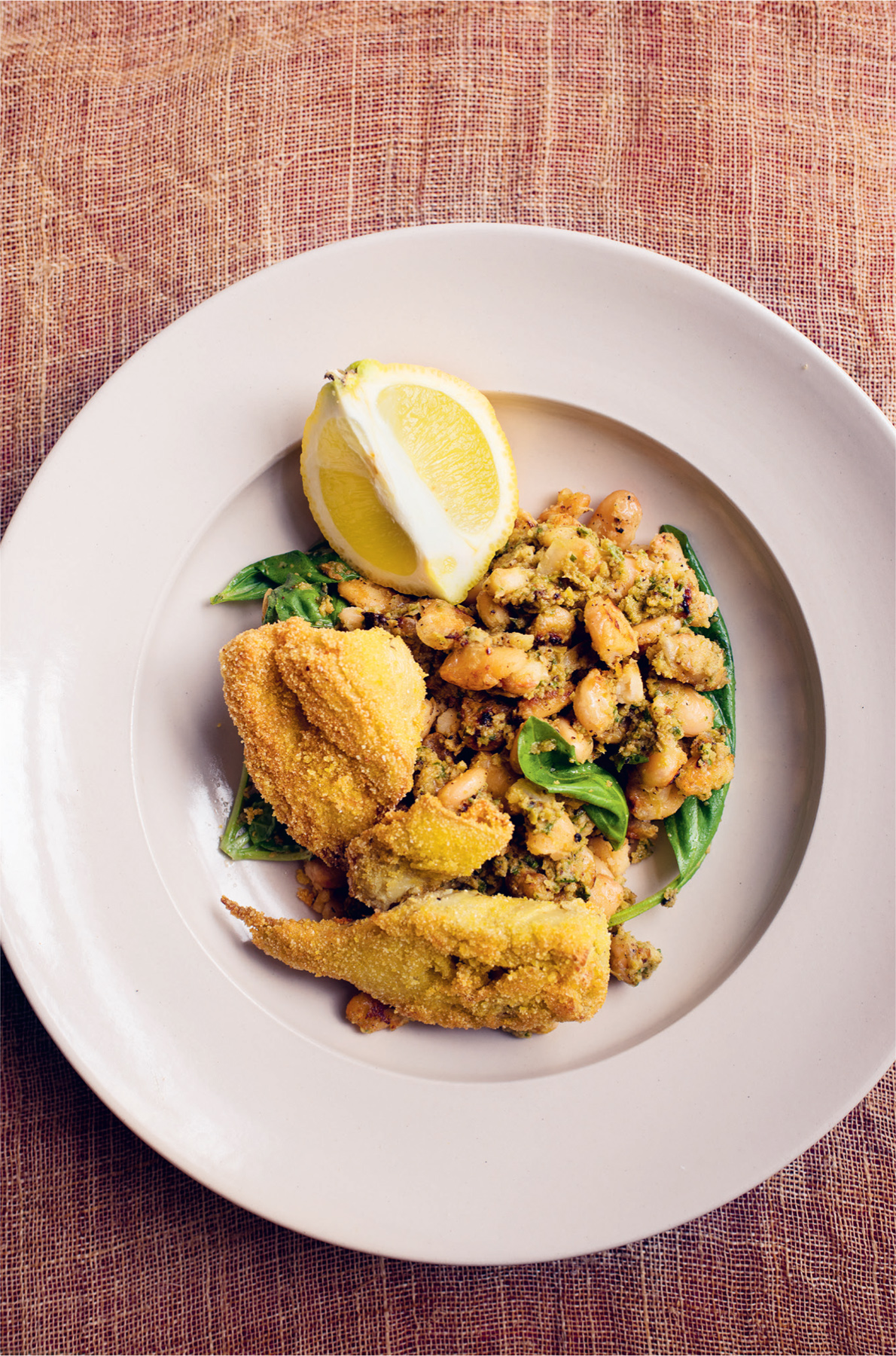
ARTICHOKES, BEANS, GREEN OLIVES
Crisp beans and fried artichokes. Dinner from the deli.
Serves 2
green olives, stoned 200g
olive oil 100ml
basil 20 leaves
lemon juice 75ml
parsley leaves from a small bunch
black garlic 2 cloves
olive oil, for frying 2 tablespoons
haricot beans 1 × 400g can
fine ground polenta 6 tablespoons
eggs 2
artichokes in oil 350g
groundnut oil, for deep frying
Put the olives into the jug of a blender, then add the olive oil, basil leaves, lemon juice, parsley leaves and black garlic. Reduce to a thick purée.
Warm the olive oil in a shallow pan that doesn’t stick, drain the beans and add them to the pan, then let them cook over a moderate heat, turning occasionally, until they are lightly crisp.



